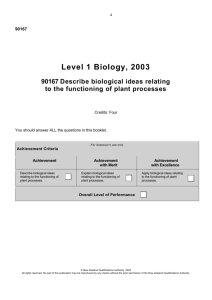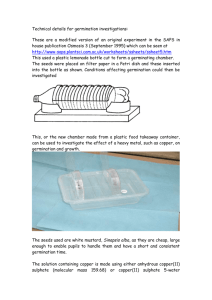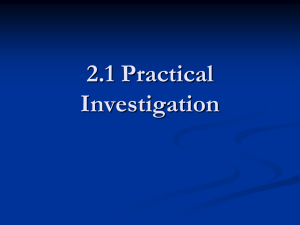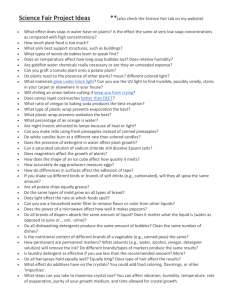2. Explants and surface sterilization
advertisement
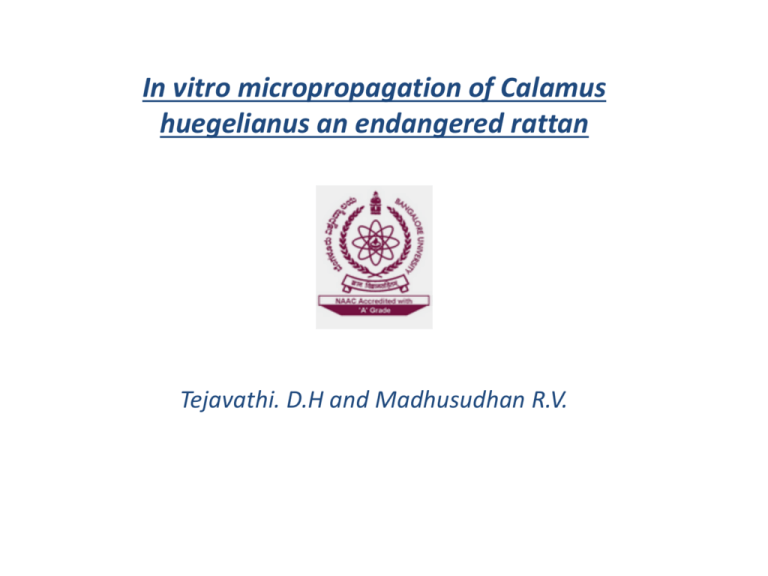
In vitro micropropagation of Calamus huegelianus an endangered rattan Tejavathi. D.H and Madhusudhan R.V. Introduction: : Calamus belongs to the family Arecaceae, and it is considered as a non timber forest product. C. heugelianus is a high climbing, clustering cane with a diameter of about 3 to 5cm with sheath and 2.5 cm without sheath. • It is economically important taxa endemic to Western Ghats. The genus Calamus is distributed in India mostly in thick ever green forests of western ghats, sub-himalayan hills and valleys of eastern and northeastern India and in Andaman and Nicobar islands. • This is a spiny climbing plant easily characterized by its beautiful large feather like leaves. The plant needs absolute shade in its early stages of development and as it grows it climbs on to the tall trees and compete for the sun light. • The stem of this plant is commonly called as cane and is used in furniture industries for manufacturing of various articles like chairs, swings, baskets etc. for many families living around forests this is the main source of income. • And because of various reasons like, deforestation, urbanization and unscientific collection of these plants have depleted the number and the diversity of the genus in the wild. Why Calamus should be mass propagated? Imbalance between demand and supply. Indiscriminate extraction of Rattans. Extraction of canes before flowering. They are dioeciously, flowers only once in a year. Percent of seed viability and germinability are very low. Seeds do not germinate if stored for long time. Vegetative propagation for mass multiplication is limited. Survival rate of suckers is very low. 1. Material and method • Frequent visits were made to Western Ghats to collect the seeds and seedlings of Calamus heugelianus for in vitro tissue culture and germination studies. • Costmary tissue culture techniques were followed to raise the plants from the explants. 2. Explants and surface sterilization:• The fruits were soaked in water for 24 hours and rubbed against each other to remove the outer wall and the sarcotesta. • The seeds were thoroughly washed with tween-20 in running water for 30min and then surface sterilized with Bevastin (0.1%), a fungicide for 30min. • The seeds were then washed in tap water to remove the traces of Bevastin for 30min. 3. Pretreatments. • GA3 treatment: seeds were kept overnight in 1, 2 and 3 mg/l of GA3 before processing them for germination. • Acid treatment: seeds were treated with 1,5 and 10% of HCL for 30min, and then washed thoroughly with sterile water before processing for germination. • Boiling water treatment: seeds were placed in muslin cloth bag immersed in boiling water for 30 min. and washed with sterile water. • Untreated seeds were considered as control. 4. Experiments. • Four experiments were selected for the germination studies, • In vitro germination studies • Paper bridge method • Desiccator method and • Germination on different substrates. 1 2 3 4 5 1 2 3 4 1 • The observations were done daily and the results were recorded. • Three parameters were studied , percentage of germination, Mean germination time (MGT) and Seedling vigor (VI). • Average of the seeds germinated were calculated for percentage germination. • For mean germination time, MGT= Ʃ(nd)/ N was utilized where n is the number seeds germinated in days d and N is the total number of seeds germinated at the end of the test period. • Seedling vigor was calculated by using VI= (R+S) G where VI is the vigor index R is the average root length, S is the average shoot length and G is germination percentage. Table 6: - Effect of various substrates on seed germination of Calamus heugelianus S.No. Substrates MGT (Days) Vigor Index 1. Soil 122.25 102.48 25.15 2. Sand 121.75 32.20 10.6 3. Compost 00 00 00 4. Compost mixture 112.75 66.00 24.75 5. Fresh cowdung 132.17 31.14 13.3 6. Fresh cowdung mixture 140.00 55.54 14.61 7. Sheep dung manure 138.75 98.00 38.64 8. 131.25 116.00 39.33 9. Sheep dung manure & mixture Cowdung manure 112.00 102.10 44.3 10. Cowdung manure & mixture 110.25 121.36 44.3 11. Ash 00 00 00 12. Ash & mixture 00 00 00 13. perlite 103.25 55.40 38.64 14. Vermiculite 102.50 56.50 38.64 % of Germination 5. RESULTS • Though the best germination percentage was seen in in vitro technique the seedling were affected severely by fungal contamination. • Desiccator method and paper bridge method showed similar results in MGT but the Seedling vigor was far superior in paper bridge method compared to all other techniques. • As a whole sheep dung manure and sheep dung manure mixture showed best results with respect to all the parameter in all four species tried. With this back ground, multiplication of rattans by tissue culture technique can be a alternate strategy for production of large quantity of planting material of genetically uniform stock and also to conserve the genetic diversity of the taxa. 2. Explants and surface sterilization:• Young leaf segments (0.75 to 1 cm2), root tips (1 cm) and shoot apices (1 cm) were excised from healthy seedlings and used as explants. • They were thoroughly washed with tween-20 in running water for 30min and then surface sterilized with Bevastin (0.1%), a fungicide for 30min. • Explants were then washed in tap water to remove the traces of Bevastin for 30min, followed by treatment with mercuric chloride (0.1%) for not more than 2 min and washed thoroughly with sterile double distilled water for 5 to 6 times to remove the traces of sterilents. 3. Culture medium • The nutrient media selected for the studies were Murashige and Skoog’s (1962) and Phillips and Collins (L2 medium, 1979). • Both the media were supplemented with various auxins- IAA, IBA, NAA, 2, 4-D and Cytokinins-BAP, Kin, 2-ip, AS and TDZ along with or without GA3 either alone or in combination at various concentrations. • Sucrose (3%) and bacteriological grade agar agar (0.8%) were used as carbon source and gelling agent respectively; pH of the medium was adjusted to 5.6-5.8 and autoclaved for 15 min at 109 Kpa. • The cultures were incubated at 25±2°C under fluorescent tube lights with 16:8 hr light and dark regime at the intensity of 25µ mol m-2s-1. Both direct and indirect organogenesis was obtained depending on the type and concentrations of the hormones supplemented to the media. L2+2, 4-D and L2+IAA+BAP were proved to be the best combination of hormones for direct and indirect regeneration respectively. With 0.9 standaerd error. L2+BAP L2 + IAA L2 + KIN 1 3 L2 + NAA 2 4 BAP + IAA BAP + NAA BAP + IBA BAP + 2,4-D 4. Rooting and acclimatization of hardened tissue cultured plants • The multiple shoots that were obtained through in vitro culture were transferred to rooting medium which was supplemented with NAA/IAA to produce roots. • After 45 to 50 days, the rooted plantlets were transferred to plastic cups containing vermiculate and kept in polyhouse. • Thus hardened plants were transferred to pots containing soil: sand: manure in 1:1:1 ratio. Three months old seedlings were transferred to field. NAA IAA Hardening CONCLUSION: • Today conservation of the phyto diversity is the order of the day. As the ever increasing pressure on forests because of urbanization and encroachment of forest for farming in on high. • The above mentioned protocol helps to generate large number of saplings in short time and also reduces the pressure on wild plants. • And this the protocol can also be very efficient in increasing the production of cane and in meeting the demand which will mainly help in upgrading the rural economy. Thank you


